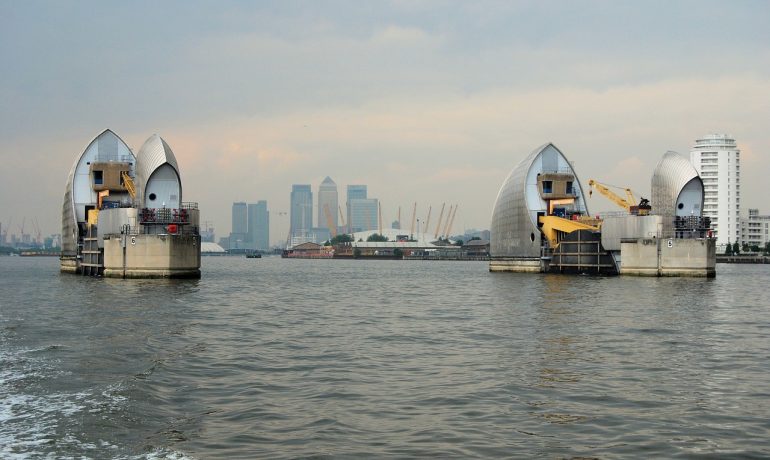The Environment Agency has decided to improve London’s tidal defences by 2050 – 15 years earlier than anticipated. Sea levels are expected to rise by a metre by 2100. And that means the Thames Barrier, which has been closed 207 times since its introduction in 1982, needs to be looked at. And hard.
The Barrier is planned to continue in service until 2070. But if it is to continue to protect the capital until 2100, it will need to be improved. “That decision,” says Karen McVeigh in The Guardian, “– whether to build a new barrier or upgrade the existing one – will wait until 2040, with all options remaining open until then.”
McVeigh’s article quotes Professor Ivan Haigh of the University of Southampton ““With 1 metre of sea level rise, you could go from 10 closures a year to many hundreds of closures a year – perhaps up to 300.””
The Environment Agency, and London, confront one of the great problems of planning for climate impacts. What do we do, and when?
It’s not just London that takes time to develop these projects though. The MOSE project – which started in 1984 – protects Venice from the acqua alta. Or at least, it does at the moment. MOSE’s aim is to protect Venice from sea level rises of up to 60cm, and has already been used 49 times since its activation in 2020. A full 1m rise though will overtop the defences entirely.
That uncertainty about what to do and when is one of the reasons we started the Sustainability Innovation Pathway project. Technology has a lead time, and that lead time can be very long indeed. Not only does the technology have to exist, but the factories to manufacture it have to be built, the tools made, the raw materials sourced, the funding secured. And then, when all of that has been done, the technology has to be manufactured at scale, and introduced. And then – and only then – can it start having an effect.
In the SIP, we use technology readiness levels (TRLs) as a basic input to our thinking. Essentially, a technology readiness level of 1 is an idea sketched on the back of an envelope (fag packets are now too expensive to sketch anything on); a TRL of 10 means a technology is fully mature and in widespread use. The development velocity of a technology can be influenced by many things – of which the two key ones are money, and urgent need. Urgent need usually encourages money – think of the development of vaccines for coronavirus, which went from a need to deployment in under a year.
Money without immediate need is more difficult, because in that case it has to fit into someone else’s planning and budgeting cycle. Governments need to be persuaded, private capital has to be enticed and rewarded, other priorities have to be downscaled. And all on the presumption that something in the future might happen.
For the Thames Barrier, all the published timings are comfortably far away. 2040 for the decision date, 2070 for the in-service date, 2100 for the sea to rise a metre.
There is, of course, no proof that we have that time. This June was the warmest for the UK on record. The average global air temperature recorded 2 metres above Earth’s surface was over 17°C (62.6°F) on 3 July, the highest that has ever been recorded. An analysis last year of more than 200 papers identified six tipping points which are unnervingly close.
And things change fast. When a film called “The Flood” in was released in 2007, a spokesperson for the Environment Agency confidently said “If we use the barrier in combination with other options – such as flood storage – we know that the barrier will be effective up until 2100.””
It is that “we know” which makes the hair stand up on the back of the necks of futurists. We “know” nothing about the future. Between 2007 and 2023, things have changed so much that one of the largest pieces of civil engineering in the UK now needs to be reconsidered.
It is one of our maxims in developing scenarios that no scenario of itself will come true – but bits of all of them will. Our scenarios for the future include climate impacts – now they must also keep up with their rate of change. Because even our most massive engineering projects, of which the Thames Barrier and MOSE are just two examples, take too long to plan, too long to build, and the assumptions which underlie their construction are simply no longer true.
Where does this take us? Futures thinking needs to accommodate and communicate the pace of change. Government and industry need to shorten funding and development timelines so we can meet future needs faster. And the development velocity of technologies needs to increase.
This all requires money, and determination. At exactly the time when the world is still not recovered from the 2008 financial crisis, is dealing with a major land war in Europe, and when disinformation makes determined unified action all the more difficult. But without it, neither MOSE nor the Thames Barrier, to take only two examples, will not be ready for the world of 2100.
And that assumes the climate is good enough to stick to our scenarios – which it shows few signs of doing.
Written by Jonathan Blanchard Smith, SAMI Fellow and Director
The views expressed are those of the author(s) and not necessarily of SAMI Consulting.
Future-prepared firms outperform the average by 33% higher profitability and 200% higher growth. SAMI Consulting brings 30 years of experience delivering foresight, futures and scenario planning – enabling companies and organisations make “robust decisions in uncertain times”. Find out more www.samiconsulting.co.uk.
If you enjoyed this blog from SAMI Consulting, the home of scenario planning, please sign up for our monthly newsletter at newreader@samiconsulting.co.uk and/or browse our website at https://www.samiconsulting.co.uk
Featured image by Steve Bidmead from Pixabay


